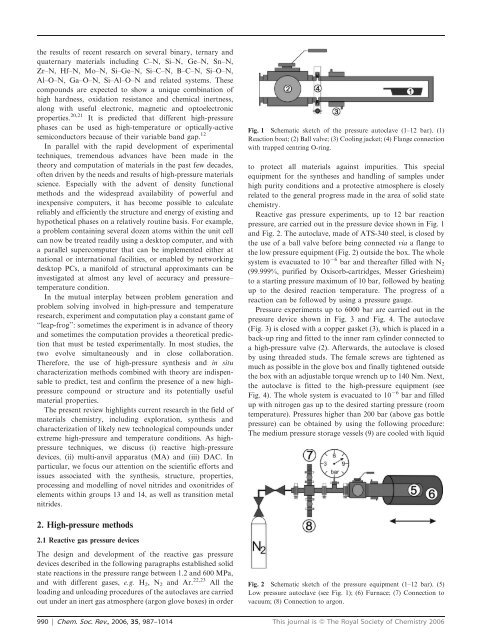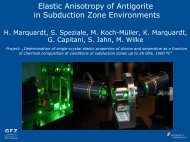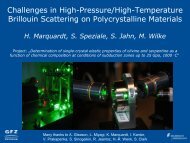High-pressure chemistry of nitride-based materials
High-pressure chemistry of nitride-based materials
High-pressure chemistry of nitride-based materials
You also want an ePaper? Increase the reach of your titles
YUMPU automatically turns print PDFs into web optimized ePapers that Google loves.
the results <strong>of</strong> recent research on several binary, ternary and<br />
quaternary <strong>materials</strong> including C–N, Si–N, Ge–N, Sn–N,<br />
Zr–N, Hf–N, Mo–N, Si–Ge–N, Si–C–N, B–C–N, Si–O–N,<br />
Al–O–N, Ga–O–N, Si–Al–O–N and related systems. These<br />
compounds are expected to show a unique combination <strong>of</strong><br />
high hardness, oxidation resistance and chemical inertness,<br />
along with useful electronic, magnetic and optoelectronic<br />
properties. 20,21 It is predicted that different high-<strong>pressure</strong><br />
phases can be used as high-temperature or optically-active<br />
semiconductors because <strong>of</strong> their variable band gap. 12<br />
In parallel with the rapid development <strong>of</strong> experimental<br />
techniques, tremendous advances have been made in the<br />
theory and computation <strong>of</strong> <strong>materials</strong> in the past few decades,<br />
<strong>of</strong>ten driven by the needs and results <strong>of</strong> high-<strong>pressure</strong> <strong>materials</strong><br />
science. Especially with the advent <strong>of</strong> density functional<br />
methods and the widespread availability <strong>of</strong> powerful and<br />
inexpensive computers, it has become possible to calculate<br />
reliably and efficiently the structure and energy <strong>of</strong> existing and<br />
hypothetical phases on a relatively routine basis. For example,<br />
a problem containing several dozen atoms within the unit cell<br />
can now be treated readily using a desktop computer, and with<br />
a parallel supercomputer that can be implemented either at<br />
national or international facilities, or enabled by networking<br />
desktop PCs, a manifold <strong>of</strong> structural approximants can be<br />
investigated at almost any level <strong>of</strong> accuracy and <strong>pressure</strong>–<br />
temperature condition.<br />
In the mutual interplay between problem generation and<br />
problem solving involved in high-<strong>pressure</strong> and temperature<br />
research, experiment and computation play a constant game <strong>of</strong><br />
‘‘leap-frog’’: sometimes the experiment is in advance <strong>of</strong> theory<br />
and sometimes the computation provides a theoretical prediction<br />
that must be tested experimentally. In most studies, the<br />
two evolve simultaneously and in close collaboration.<br />
Therefore, the use <strong>of</strong> high-<strong>pressure</strong> synthesis and in situ<br />
characterization methods combined with theory are indispensable<br />
to predict, test and confirm the presence <strong>of</strong> a new high<strong>pressure</strong><br />
compound or structure and its potentially useful<br />
material properties.<br />
The present review highlights current research in the field <strong>of</strong><br />
<strong>materials</strong> <strong>chemistry</strong>, including exploration, synthesis and<br />
characterization <strong>of</strong> likely new technological compounds under<br />
extreme high-<strong>pressure</strong> and temperature conditions. As high<strong>pressure</strong><br />
techniques, we discuss (i) reactive high-<strong>pressure</strong><br />
devices, (ii) multi-anvil apparatus (MA) and (iii) DAC. In<br />
particular, we focus our attention on the scientific efforts and<br />
issues associated with the synthesis, structure, properties,<br />
processing and modelling <strong>of</strong> novel <strong>nitride</strong>s and oxo<strong>nitride</strong>s <strong>of</strong><br />
elements within groups 13 and 14, as well as transition metal<br />
<strong>nitride</strong>s.<br />
Fig. 1 Schematic sketch <strong>of</strong> the <strong>pressure</strong> autoclave (1–12 bar). (1)<br />
Reaction boat; (2) Ball valve; (3) Cooling jacket; (4) Flange connection<br />
with trapped centring O-ring.<br />
to protect all <strong>materials</strong> against impurities. This special<br />
equipment for the syntheses and handling <strong>of</strong> samples under<br />
high purity conditions and a protective atmosphere is closely<br />
related to the general progress made in the area <strong>of</strong> solid state<br />
<strong>chemistry</strong>.<br />
Reactive gas <strong>pressure</strong> experiments, up to 12 bar reaction<br />
<strong>pressure</strong>, are carried out in the <strong>pressure</strong> device shown in Fig. 1<br />
and Fig. 2. The autoclave, made <strong>of</strong> ATS-340 steel, is closed by<br />
the use <strong>of</strong> a ball valve before being connected via a flange to<br />
the low <strong>pressure</strong> equipment (Fig. 2) outside the box. The whole<br />
system is evacuated to 10 26 bar and thereafter filled with N 2<br />
(99.999%, purified by Oxisorb-cartridges, Messer Griesheim)<br />
to a starting <strong>pressure</strong> maximum <strong>of</strong> 10 bar, followed by heating<br />
up to the desired reaction temperature. The progress <strong>of</strong> a<br />
reaction can be followed by using a <strong>pressure</strong> gauge.<br />
Pressure experiments up to 6000 bar are carried out in the<br />
<strong>pressure</strong> device shown in Fig. 3 and Fig. 4. The autoclave<br />
(Fig. 3) is closed with a copper gasket (3), which is placed in a<br />
back-up ring and fitted to the inner ram cylinder connected to<br />
a high-<strong>pressure</strong> valve (2). Afterwards, the autoclave is closed<br />
by using threaded studs. The female screws are tightened as<br />
much as possible in the glove box and finally tightened outside<br />
the box with an adjustable torque wrench up to 140 Nm. Next,<br />
the autoclave is fitted to the high-<strong>pressure</strong> equipment (see<br />
Fig. 4). The whole system is evacuated to 10 26 bar and filled<br />
up with nitrogen gas up to the desired starting <strong>pressure</strong> (room<br />
temperature). Pressures higher than 200 bar (above gas bottle<br />
<strong>pressure</strong>) can be obtained by using the following procedure:<br />
The medium <strong>pressure</strong> storage vessels (9) are cooled with liquid<br />
2. <strong>High</strong>-<strong>pressure</strong> methods<br />
2.1 Reactive gas <strong>pressure</strong> devices<br />
The design and development <strong>of</strong> the reactive gas <strong>pressure</strong><br />
devices described in the following paragraphs established solid<br />
state reactions in the <strong>pressure</strong> range between 1.2 and 600 MPa,<br />
and with different gases, e.g. H 2 , N 2 and Ar. 22,23 All the<br />
loading and unloading procedures <strong>of</strong> the autoclaves are carried<br />
out under an inert gas atmosphere (argon glove boxes) in order<br />
Fig. 2 Schematic sketch <strong>of</strong> the <strong>pressure</strong> equipment (1–12 bar). (5)<br />
Low <strong>pressure</strong> autoclave (see Fig. 1); (6) Furnace; (7) Connection to<br />
vacuum; (8) Connection to argon.<br />
990 | Chem. Soc. Rev., 2006, 35, 987–1014 This journal is ß The Royal Society <strong>of</strong> Chemistry 2006





